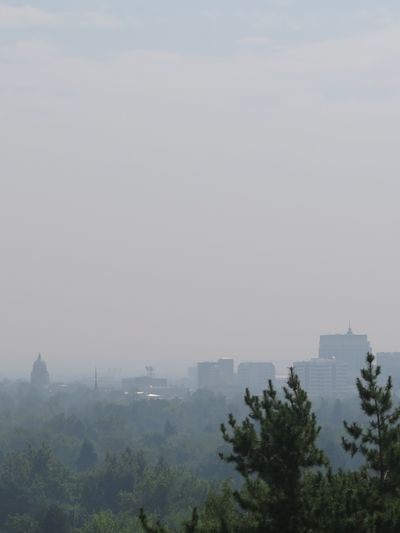Statewide air quality alert lifted due to improvement in eastern Idaho, but most of state still under pall

It may not look like it, but on a statewide basis, air quality has improved in Idaho, and the DEQ allowed its statewide air quality alert for wildfire smoke to expire at 10 a.m. today – though regional advisories continue in most areas with all the same restrictions, including banning all open burning. The places where it’s better: Twin Falls, Pocatello, and Idaho Falls. At 2 p.m. today, the air quality index in Twin Falls dropped down to 43, entering the green or “good” range. Pocatello’s 2 p.m. reading was an AQI of 96, toward the top of the yellow or “moderate” range, as was Idaho Falls, at 99.
But much of the rest of the state still is seeing unhealthy, very unhealthy or even “hazardous” air.
“We did get some pretty good clearing last night,” said Mike Toole, airshed coordinator for the Idaho Department of Environmental Quality. “It might not be reflected in the numbers per se because we were so high, but in some areas we cut our numbers by two-thirds, though we’re still in the red.”
At noon today, Boise’s air quality index was 159, which is in the red, or “unhealthy” range. Coeur d’Alene was at 198, also in the red; Cottonwood is into the purple or “very unhealthy” range at 257, as is Sandpoint at 224; and Porthill, clear up by the Canadian border, is at a whopping 427 AQI, which is in the maroon, or “hazardous” range.
Ketchum was down into the moderate range with an AQI of just 87 at noon, but the forecast there is for it to go right back up into the orange range (“unhealthy for sensitive groups”). Lewiston is at 200; McCall, 155; Moscow, 174; Weiser, 176. Spokane’s 11 a.m. reading was 181, which like Boise is in the red or unhealthy zone.
Here’s the breakdown between the ranges: 0-50 is green or good; 51-100 is yellow or moderate; 101-150 is orange or “unhealthy for sensitive groups;” 151-200 is red or “unhealthy;” 201-300 is purple or “very unhealthy;” and 301 to 500 is maroon or “hazardous.”
“This afternoon, as the inversion lifts and then Saturday and Sunday, we’re going to see some progressive improvements,” Toole said, with the Boise area’s air possibly heading toward the yellow range, but more likely staying in the orange zone. “Looking ahead, Sunday afternoon and Monday there’s going to be another shift in the weather to bring us more northwest flow.” While southern Idaho may stay in the yellow to orange range, northern Idaho likely will remain “in the red or even higher.”
“There is hope that later next week there might be a good storm system come through, not only to help with air quality but help with some of the firefighters on the lines and suppress the fire activity,” Toole said, but that’s “still a ways off. … We’re waiting to see what happens.”
* This story was originally published as a post from the blog "Eye On Boise." Read all stories from this blog